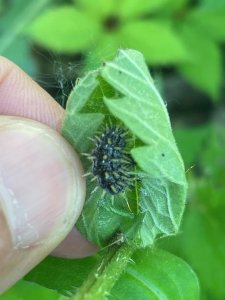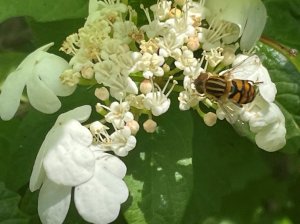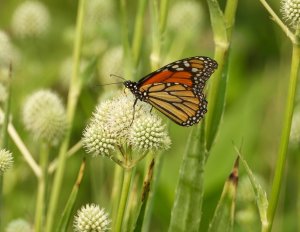What is Garden Ecology and How Does it Impact Your Life?
May 29, 2024
By: Alexis Olechowski, Park Interpreter
When we hear the word “ecology” we may not first think of our gardens and backyards. But these spaces are full of interconnected food webs where organisms find habitat, food, water, and shelter. While many of these creatures may be small, they are important parts of our garden ecosystems! So, what exactly makes up garden ecology? It encompasses a multitude of components such as soil nutrient levels, pollinators, and native plants. Let’s take a look at some of these various components to better understand both gardens and they’re role in our backyard ecosystems!
The term “garden” is remarkably expansive, encompassing everything from potted plants on a patio to sprawling acres of arboretums. By definition gardens represent a human-influenced system centered around plants. Typically, a garden consists of a diverse array of plants and spaces, like a natural ecosystem. What sets it apart is the element of control, known as cultivation. Human decisions and aesthetic preferences heavily dictate the plant species thriving within a garden. Even the most naturalistic gardens bear traces of human intervention, linking human influence and garden composition.
Derived from the Greek word “oikos,” meaning “household,” “home,” or “place to live,” ecology explores the intricate relationships and interactions between organisms and their environment—the very essence of their habitat. This field of study, although relatively young, traces its roots back to the early 1900s. Initially, the focus primarily rested on the separate study of animal and plant communities. However, a pivotal shift occurred as American biologists began to recognize the interconnectedness of these communities. This shift marked a crucial turning point in the field of ecology, emphasizing the profound interdependence (the dependence of two or more people or things on each other) and symbiosis (a mutually beneficial relationship between different people or groups) that exists between the different plants and animals living within ecosystems.

Ecological research traditionally centers on natural or semi-natural environments such as oceans, forests, or mountains. This approach allows for the observation of undisturbed, flourishing ecosystems, enabling us to pinpoint issues in degraded or endangered areas impacted by human activities. By doing so, we can enhance environmental quality, manage natural resources more effectively, and safeguard human health.
However, this emphasis on pristine wilderness reinforces the prevailing perception of nature as something distant—existing “out there,” far removed from the majority of urban dwellers. Garden and urban ecology redirect our attention from these untouched natural landscapes to the green space sanctuaries nestled within cities—think parks, greenbelts, forest preserves, and your backyard. But can these seemingly modest spaces truly support ecological dynamics? And perhaps more importantly, why should we pay attention?
Certainly, our nation’s existing array of national parks, wildlife refuges, state parks, and local green spaces all serve vital roles in conservation. However, these areas often face challenges such as fragmentation, leaving wildlife struggling to find essential resources in the vast distances between protected areas. Unlike humans, animals can’t rely on grocery stores or suburban developments for their needs. It’s essential to recognize that ecosystem conservation extends beyond protected areas like national parks and forests. Concepts from garden and urban ecology offer potential solutions by creating connections between these spaces, ensuring the survival of native habitats and the species that depend on them. A considerable portion of land in the United States is privately owned and often utilized for unproductive purposes such as expansive lawns or monoculture farming. By repurposing just half of America’s lawns into ecologically productive spaces, we could unlock over 20 million acres of potential habitat, equivalent to nearly ten Yellowstone National Parks.
Imagine a vast, interconnected National Park system that not only sustains diverse wildlife but also extends right into your own backyard. Such an interconnected network could serve as a powerful tool in addressing the climate crisis and preventing ecological collapse, a looming threat that some experts warn could trigger a sixth mass extinction event. While this vision may seem ambitious, it challenges the traditional view of “nature” confined solely to remote wilderness areas, acknowledging the significance of everyday landscapes where most Americans live and interact with nature.
The brilliance of this idea lies in its simplicity and accessibility. Ordinary citizens, without specialized training, can contribute to this habitat restoration effort with minimal expense and no need for costly infrastructure changes. While contiguous plots would be ideal, even scattered patches can make a meaningful impact. By reducing the distances that pollinators, mammals, and birds must travel for food, every effort aids in their survival and the preservation of our natural world.

That means every individual who tends to even the smallest plot of land becomes an important piece of its ecology puzzle. Together, they, along with other inhabitants and elements of the city, collectively shape the ecological landscape of the urban environment. The actions taken on these small spaces—what thrives and what struggles to survive—multiplied across hundreds, thousands, or even hundreds of thousands of individual gardens, possess the power to significantly impact the ecosystem and overall health of the entire city.
So, what exactly is garden ecology? It’s the intricate interrelationship between humans and the surrounding natural elements—plants, animals, stones, and streams—among which we make our homes. It encapsulates the intertwined symbiosis between humans and the surrounding natural elements. It’s a revelation that nature isn’t confined solely to remote wilderness; rather, it’s intimately present in our yards. It’s within the delicate petals of your flowers, where pollinators sip nectar, within the protective branches of your trees where birds find refuge, underfoot where insects scurry, and buzzing past your nose, a reminder of life’s constant presence.

Garden ecology is about you and your living environment—how you thrive within it and the type of ecosystem you nurture and cultivate. It’s a celebration of our interconnectedness with the natural world and the power we hold to shape and sustain it. As our awareness of the consequences of our actions grows, so does our duty to care for our natural surroundings. With influence comes accountability, and it’s up to us to wield our power wisely. Even the smallest changes in how we tend to our gardens can ripple far beyond our property lines, extending benefits not only to local wildlife but also to our own well-being. Creating an eco-friendly garden isn’t just a passing trend; it’s a meaningful step toward a sustainable future for all.
Below, we highlight different facets of eco-friendly gardening, each tackling various ecological impacts of traditional gardening practices. Additionally, we provide a list of practical tips to help you create your own backyard ecosystem. To further explore the ecological connection between your backyard and the natural world, check out our other articles “Native Plants for Wildlife and Climate” and “Harnessing the Power of Lawns.”
Biodiversity Preservation Gardening often involves using synthetic chemicals and pesticides that harm pollinators like bees and butterflies. By choosing eco-friendly alternatives, you can create a habitat that supports various wildlife, from insects to birds, contributing to a healthier ecosystem.
Reducing Carbon Footprint Gardening typically demands significant water and energy usage. Embracing eco-friendly approaches, such as rainwater harvesting, composting, and prioritizing native plants, allows for a considerable reduction in your garden’s carbon footprint. These methods not only conserve resources but also offer long-term financial savings.
Soil Health chemical fertilizers and pesticides can harm soil quality over time. Eco-friendly gardening focuses on organic methods like using compost and mulch to enrich the soil. Healthy soil is crucial for successful and sustainable gardening, allowing plants to grow naturally without the need for harmful chemicals.
Water Conservation Water scarcity is a growing concern in many regions. Eco-friendly gardens employ water-efficient techniques such as drip irrigation, mulching, and choosing drought-tolerant plants. These strategies not only conserve water but also help prevent soil erosion and promote water quality.
Reducing Waste Eco-friendly gardening practices include recycling and repurposing materials, reducing garden waste, and composting. These actions reduce the amount of waste sent to landfills and minimize your ecological footprint.
Tips for creating an eco-friendly garden:
Choose Native Plants
Adding native plants that thrive in your region reduces the need for excessive water and maintenance. Native plants also support local wildlife by providing essential food and shelter.
Rainwater Harvesting
Collect rainwater in barrels or cisterns to irrigate your garden. Rainwater is free, chlorine-free, and ideal for plants. It’s a sustainable way to reduce your dependence on municipal water sources.
Organic Gardening
Opt for organic fertilizers, compost, and natural pest control methods to maintain healthy soil and protect beneficial insects. Avoid chemical herbicides and pesticides that can harm the environment and contaminate groundwater.
Mulching
Mulch helps retain soil moisture, suppress weeds, and regulate soil temperature. Use organic mulch like wood chips, straw, or leaves to improve soil health and reduce water consumption.
Wildlife-Friendly Features
Incorporate bird feeders, bee-friendly plants, and bird baths to attract and support local wildlife. Create a balanced ecosystem where beneficial insects, birds, and other creatures can thrive.
Reduce Lawn Size
Lawns demand extensive resources to maintain. Consider reducing your lawn’s size and replacing it with native plants, ground covers, or a vegetable garden. This not only conserves resources but also enhances biodiversity.
Composting
Composting kitchen scraps and garden waste reduces landfill contributions and enriches your soil. Compost provides essential nutrients to your plants, promoting their growth without chemical fertilizers.
Sustainable Hardscaping
When incorporating pathways, patios, or other hardscape features, choose eco-friendly materials like natural or reclaimed wood or stone. These materials have a lower environmental impact than concrete or asphalt.
Equip outdoor lights with motion sensors
White lights blazing all night can disturb animal behavior. LED devices use less energy, and yellow light attracts fewer flying insects.
Remove invasive plants
Introduced plants sustain less animal diversity than natives do. Worse, some exotics crowd out indigenous flora. Notable offenders: Japanese honeysuckle, Oriental bittersweet, multiflora rose and kudzu.
